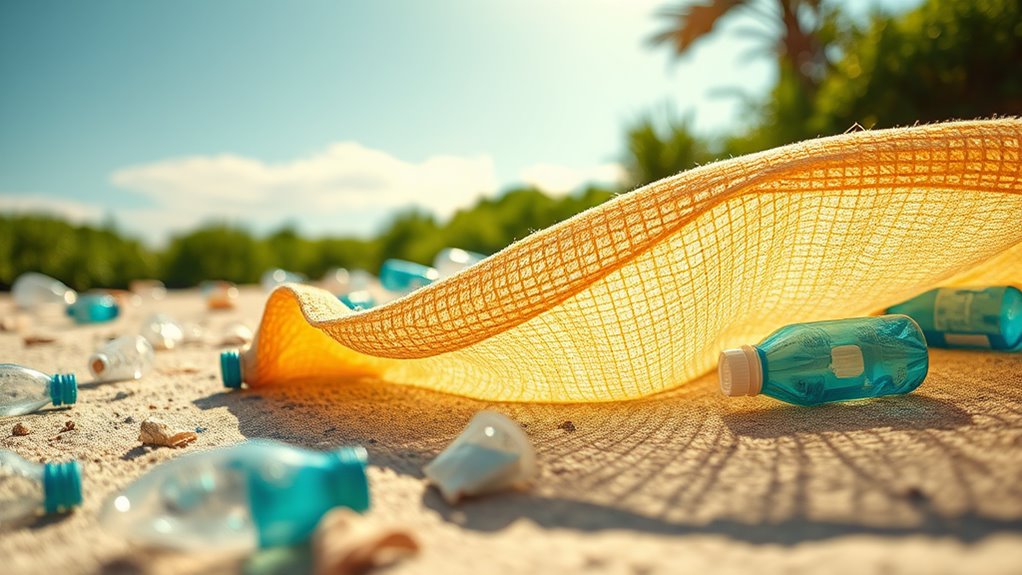
rPET, or recycled polyethylene terephthalate, is essential for sustainability because it repurposes used plastics, like bottles, minimizing waste and reducing reliance on virgin materials. By recycling PET, it cuts down energy consumption and greenhouse gas emissions considerably, resulting in a lower carbon footprint. Plus, rPET can be recycled multiple times, enhancing its durability. This recycling process conserves natural resources and reduces pollution, making it a key component of a more sustainable future. Discover more about its applications and benefits further on.
As the world grapples with plastic pollution, understanding the role of recycled polyethylene terephthalate (rPET) becomes imperative. rPET is a sustainable plastic derived from used PET materials like plastic bottles. The production process involves collecting, sorting, cleaning, and transforming these waste products into new materials. This method not only reuses existing plastics but also appreciably cuts down on energy consumption compared to the production of virgin PET. By sourcing raw materials from post-consumer waste, rPET plays an essential role in mitigating environmental impact and reducing pollution.
Understanding rPET is crucial in combating plastic pollution by transforming waste into sustainable materials while reducing energy consumption.
When you consider the benefits of rPET, you can see how it conserves non-renewable resources. Instead of extracting new raw materials, rPET reuses existing plastic, which directly reduces the amount of waste sent to landfills or oceans. In addition, the production of rPET emits fewer greenhouse gases than virgin PET, resulting in a lower carbon footprint. It's remarkable that rPET can undergo multiple recycling processes, adding to its appeal as a durable and low-maintenance material. This durability guarantees that products made from rPET can withstand regular use without degrading quickly. Moreover, the efficient recycling processes ensure that a larger percentage of PET materials are captured and reused, further enhancing sustainability.
In comparison to regular plastic, rPET stands out for its resource efficiency. The energy required to produce rPET is notably lower than that for virgin plastics, and it also uses less water. This efficiency translates into a reduced environmental impact, as it minimizes the need for raw material extraction. By utilizing existing materials, rPET helps to create a more sustainable model for plastic production and consumption.
You might encounter rPET in various applications, from bottles and food containers to textile fibers used in clothing. It's also common in packaging materials, household items like welcome mats and pillows, and even sportswear. Each of these uses showcases the versatility of rPET and its potential to replace traditional plastics in everyday products. By choosing rPET-based items, you can actively participate in reducing plastic pollution.
However, there are challenges and limitations associated with rPET. The recycling efficiency of PET products can be hindered by inefficient systems, and advanced recycling methods tend to be costly and less common. rPET's success depends heavily on existing plastic recycling infrastructure, which varies globally. Quality control is also essential, especially for food-grade applications, as maintaining the integrity of rPET flakes becomes imperative.
Despite these challenges, the sustainability impact of rPET can't be overlooked. It directly contributes to reducing plastic waste and supports sustainable development goals by promoting responsible consumption and production. With a growing demand for eco-friendly alternatives, rPET encourages a circular economy by reusing materials and conserving natural resources.
Conclusion
As you consider the journey of RPET, imagine plastic bottles transformed into vibrant fabrics, reducing waste and conserving resources. This innovative material not only lessens the environmental burden but also paves the way for a circular economy. By choosing products made from RPET, you're not just making a purchase; you're participating in a movement toward sustainability. The question remains: will you take the next step in this crucial journey, or let the plastic waste of yesterday define our tomorrow?



